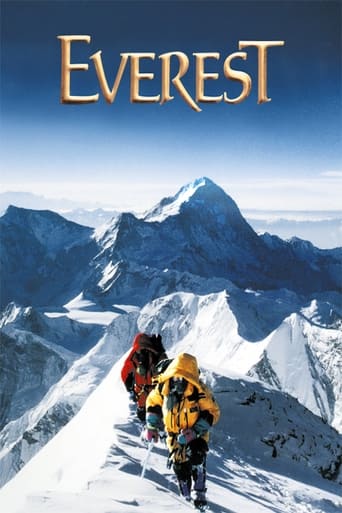Syl
I may not be physically able to climb Mount Everest. I do hope one day to see Everest from a distance. The joy in reaching the summit was important for this gang of ultimate mountaineers. There are many here who plan to make the summit. I wished there was more to this documentary though. I know the story of how the deadly storm killed many that time. Everest is the ultimate goal for those who are mountain climbers but it is very dangerous even for the healthy. You can climb Everest at your own risk though after spending thousands of dollars to get there.
mwngai
Within 46 minutes, the movie spent too much time on things that are not related to climbing: introduction of climbers, expression of their feelings. The coverage of climbing is not enough. Nothing exciting about.Go for "Surviving Everest" produced by National Geographic. It is far better than this movie.-- Dave
Kakueke
This superb documentary contains beautiful shots of Mt. Everest and its surroundings, as well as discerning cinematography to make us aware of the challenges involved in scaling it. Great on IMAX, without a doubt! "Everest" insists on making us know how much oxygen is an issue as well as weather and temperature. There are, of course, other challenges. As to the tragic parties: "Everest" does a good job in presenting the logistical problems they faced as their fates were being sealed. Up and down the mountain, at different stations and spots. Though the climbers are obviously brave, their recklessness limits the sympathy we feel for them. But perhaps the most noteworthy thing to take from this film is that it is simply crazy to want to climb Mt. Everest, at least for me. What a great risk of death or permanent bodily harm! More than just a high climb straining your legs!
mbhuens1
The film I saw is certainly not the one that deserved to be the most successful IMAX film in history. The film seems boring, with long stretches given to 'surfer' talk by arrogant, not-so-heroic athletes. Macho shouldn't be confused with heroism. Also, why aren't the contributions of the Sherpas (guides and haulers who are Tibetan) shown? Are the filmmakers afraid that the climbers with look like lilies? And finally, when a film gets this much positive criticism and makes a bucket of money, isn't it a bit creepy to learn (in the end credits) that some of the climbing scenes were re-created and shot in the United States? The film is more of a stunt than a valid filmmaking format at this point, and the filmmakers working in it are a long way from Lean or Spielberg.



